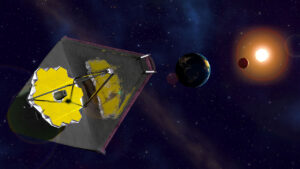Take a moment to consider your age. For most people reading this, I imagine you’re somewhere between 18 and 100. Now, compare that to the age of UNC, which was chartered in 1789: 232 years ago. The world was so different in many ways, scientifically, culturally, socially, etc. The United States was founded just thirteen years prior to that. Now, look back even further to the first emergence of humanity as we know it today, roughly 200,000 years ago. Regardless of how old you are, you have existed for no more than 0.05% of that duration. Over the course of that timeline, countless wars had been waged, civilizations rose and fell, tens of thousands of generations of people passed through this world with hopes and dreams, many unknowingly passing on their genetic attributes to you from so many years ago. Now, think back even further, before humanity, before even the Earth itself came into existence. Think back to the beginning of the universe as we know it: the Big Bang, 13.8 billion years ago. The cataclysmic event brought forth matter and energy, the basic elements of life, collectively forming galaxies of stars and planets. As humans, none of us nor our earliest ancestors have ever witnessed these early remnants of the first chapter of our universe. However, that could all change very soon with the James Webb Space Telescope.

On Christmas Day 2021, astronomers around the world celebrated this day not necessarily for the eponymous religious/cultural holiday, but for the successful launch of the James Webb Space Telescope. Succeeding the Hubble Space Telescope, the James Webb Space Telescope is the culmination of a multi-billion dollar investment and international effort to survey beyond the known universe. Named after James Webb – the former head of NASA from 1961 to 1968 – it is expected to uncover mysteries of not just our solar system, but what our universe looked like within those first few million years after the Big Bang.

How can this telescope survey something that happened eons in the past? The James Webb Space Telescope measures the speed at which light travels from distant objects. For us on Earth, it takes light an infinitesimal amount of time to reach us. That’s because light travels 300 million meters per second or 186,000 miles per second, and the Earth is only 7,907.5 miles in diameter. Therefore, it can appear instantaneous to us when we see people and objects in everyday life. However, the same cannot be said for the universe at large. Take the Moon, for example. It orbits roughly 240 thousand miles away from the Earth, so it takes light approximately 1.25 seconds to reach us. In other words, when we’re gazing up at the Moon at night, we’re looking at it 1.25 seconds in the past. Hypothetically, if the Moon were suddenly obliterated, we wouldn’t see it until 1.25 seconds later. By looking at infrared light with the James Webb Telescope, astronomers will have a front-row seat to the birth of some of the first stars and galaxies of the universe.
The capabilities of the Webb go beyond just looking at nascent stars; it could also answer this decade whether life exists beyond Earth. There are planets beyond our solar system called exoplanets. As of March 2, 2022, 4,980 exoplanets have been discovered, many of which were found by the recently retired Kepler space telescope. Some of these planets are reported to exist in habitable locations within their star systems called the Goldilocks Zone. Just like the porridge of the zone’s namesake, this means the planets within this region are neither too hot nor too cold, making them eligible candidates for having atmospheres that could host life. Webb has the equipment and conditions necessary to discern whether any of these planets could indeed harbor life, specifically by taking advantage of the spectrum of light. Light exists at different wavelengths which correspond to different colors. We can detect some of these colors with our naked eyes like scarlet and violet, while others are beyond our perception, such as those at ultraviolet and infrared wavelengths. By measuring the spectra of light at different wavelengths, scientists can profile a planet’s atmosphere. For example, water molecules absorb light from the infrared wavelength. This gives the illusion of the planet appearing bigger since the atmosphere restricts excess light from the star it’s orbiting. Working in this framework, astronomers can also measure a planet’s atmospheric temperature and identify objects within the atmosphere like clouds or perhaps novel objects in that planet’s sky. Because the James Webb Space Telescope is situated opposite of the Earth and the Sun at an orbital position called L2 or second Lagrangian point, it has an optimum window to survey these exoplanets for life-harboring atmospheres, which can inform future missions launching space telescopes and rovers to further investigate these planets. Because of the obvious widespread interest in the possibility of life on other planets and other planetary properties, some independent researchers have successfully allotted time on the telescope to study specific planets of interest. For example, a graduate student in Canada, Lisa Dang, won time to study an exoplanet discovered by the Kepler space telescope called K2-141b, a rocky planet covered in lava and molten rock. Imagine having the Webb be a part of your dissertation!
This is a very exciting time for both astronomy and mankind at large. With the scientific ingenuity of the James Webb Space Telescope, there are countless discoveries awaiting to be made. Some astronomers postulate that the James Webb Space Telescope will mark a turning point for not just science but humanity’s relatively short history as we know it. While the ongoing COVID-19 pandemic has indelibly defined the 2020s, perhaps this decade will be remembered not just for a devastating virus, but also for the first confirmation that we are not alone in the cosmos.
Peer Editor: Colleen Steward